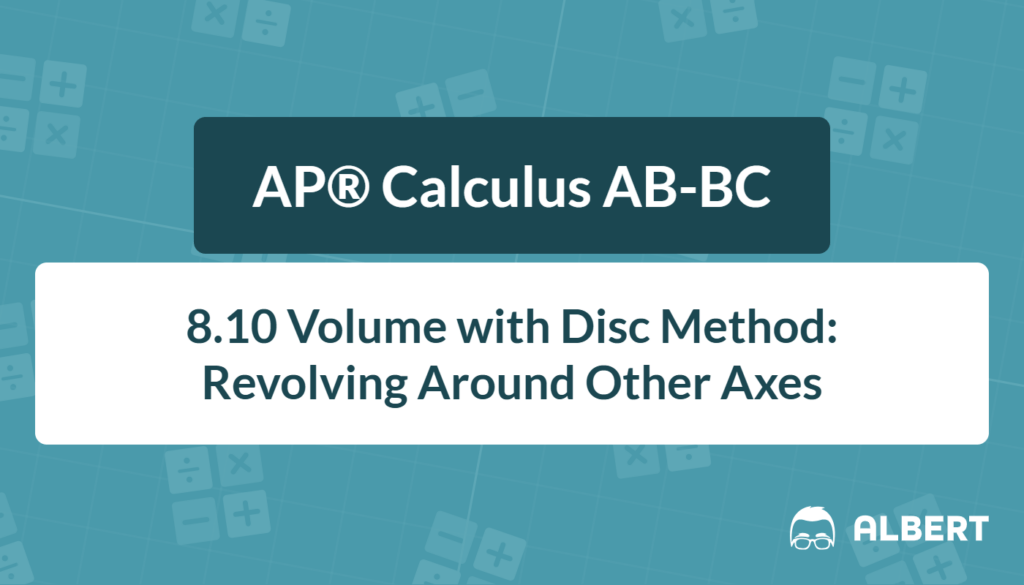Finding the volume of solid of revolution turns a flat picture into a real‐world 3-D shape—exactly the skill the AP® exam loves to test. According to the Course and Exam Description code CHA-5.C.2, students must use definite integrals with the disc method around any horizontal or vertical line. After reading, students will be able to
- recognize when to use discs or washers,
- set up integrals for unusual lines of rotation, and
- check answers with a graphing calculator.
Clear examples, step-by-step solutions, and a quick-reference chart appear below.
What We Review
Solid of Revolution Basics
What Is a Solid of Revolution?
Imagine a region on the coordinate plane attached to a pottery wheel. When the wheel spins around a line, the flat region sweeps out a 3-D object. That object is called a solid of revolution.
Disc vs. Washer at a Glance
- Disc: The region touches the axis entirely, so no hole forms.
- Washer: The region sits away from the axis, so a hollow core appears.
Think of a solid pancake (disc) versus a doughnut (washer).
Example 1 – Basic Disc Method
Revolve y=\sqrt{x} from x=0 to x=4 about the x-axis.
Step 1 Radius. Because the axis is y=0, the radius equals the y-value:
r=\sqrt{x}.Step 2 Integral. Therefore, use the formula V=\pi\int r^{2}dx:
V=\pi\int_{0}^{4}\left(\sqrt{x}\right)^{2}dx=\pi\int_{0}^{4}xdx.Step 3 Antiderivative and evaluate.
V=\pi\left[\dfrac{x^{2}}{2}\right]_{0}^{4}=\pi\left(\dfrac{16}{2}\right)=8\pi.Calculator check: fnInt(pi*x, x, 0, 4) confirms the same value.
Disc Method Around Horizontal or Vertical Lines
Formula Recap
V=\pi\int(\text{radius})^{2}d(\text{variable})Measuring Radius When the Axis Is Not a Main Axis
When rotating about a line such as y=k or x=k, the radius equals the distance from the curve to that line. Therefore, absolute value often appears.
Example 2 – Rotating About y=-2
Region: y=\sqrt{x}, x=0 to x=4; axis: y=-2.
Sketching first shows the curve sits above the line.
Step 1 Radius.
r=\sqrt{x}-(-2)=\sqrt{x}+2Step 2 Integral.
V=\pi\int_{0}^{4}\left(\sqrt{x}+2\right)^{2}dxStep 3 Expand and integrate.
\left(\sqrt{x}+2\right)^{2}=x+4\sqrt{x}+4 \rightarrow V=\pi\int_{0}^{4}\left(x+4\sqrt{x}+4\right)dx\\[4pt]=\pi\left[\dfrac{x^{2}}{2}+\dfrac{8}{3}x^{3/2}+4x\right]_{0}^{4}=\pi\left(\dfrac{16}{2}+\dfrac{8}{3}\cdot8+16\right)=\pi\left(8+\dfrac{64}{3}+16\right)=\dfrac{152\pi}{3}Washer Method for Hollow Regions
Outer Radius, Inner Radius, and Subtraction Logic
Because a washer looks like a disc with a hole, the volume subtracts the inner volume from the outer one.
V=\pi\int\bigl((R)^{2}-(r)^{2}\bigr)d(\text{variable})Common Pitfalls
- Forgetting to square both radii.
- Mixing up upper and lower curves.
- Using wrong bounds when curves intersect.
Example 3 – Region Between y=x and y=x^{2}, Rotate About the x-Axis
Step 1 Find intersections:
x=x^{2}\Rightarrow x=0,1.Step 2 Outer vs. inner curve. For 0\le x\le1, y=x sits above y=x^{2}. Therefore,
- Outer radius: R=x
- Inner radius: r=x^{2}
Step 3 Integral.
V=\pi\int_{0}^{1}\left(x^{2}-(x^{2})^{2}\right)dx =\pi\int_{0}^{1}\left(x^{2}-x^{4}\right)dx =\pi\left[\dfrac{x^{3}}{3}-\dfrac{x^{5}}{5}\right]_{0}^{1} =\pi\left(\dfrac{1}{3}-\dfrac{1}{5}\right) =\pi\left(\dfrac{2}{15}\right)=\dfrac{2\pi}{15}Rotation About Non-Axis Vertical Lines
Adjusting Radii Horizontally
When revolving around x=k, measure horizontal distance: |x-k|.
Disc vs. Washer Decision Tree
- Does the region touch the line of rotation?
- Yes → Disc.
- No → Washer.
- Is the slice vertical or horizontal?
- Vertical slice → integrate with dx.
- Horizontal slice → integrate with dy.
Graphical Interpretation and Calculator Tips
A quick sketch prevents setup errors.
- Mark intercepts and intersection points first.
- Draw the axis or line of rotation as a dashed line.
- Shade the region to be revolved.
Next, on a TI-84:
- Enter functions in [Y=].
- Use [2nd] → [Calc] → intersect for bounds.
- Choose fnInt( or ∫f(x)dx to confirm numeric answers.
Horizontal slicing (washers with respect to dy) can be visualized by turning the calculator sideways or by using an online graphing utility that supports horizontal integrals.
Quick Reference Vocabulary Chart
| Term | Definition |
| Disc Method | Uses one radius because region touches the axis, gives a solid slice. |
| Washer Method | Uses outer minus inner radius, leaves a hole. |
| Radius | Distance from curve to axis. |
| Inner Radius | Smaller radius in washer setup. |
| Outer Radius | Larger radius in washer setup. |
| Axis/Line of Rotation | Line the region spins around. |
| Bounds of Integration | Start and end values for slicing. |
Conclusion
Mastering the volume of solid of revolution boils down to three ideas:
- Choose discs when the region hugs the axis; choose washers when a gap exists.
- Measure radii as straight-line distances to any horizontal or vertical line.
- Always sketch first, then let the definite integral do the heavy lifting.
By practicing the examples above, students cover almost every AP® question tied to CHA-5.C.2.
Sharpen Your Skills for AP® Calculus AB-BC
Are you preparing for the AP® Calculus exam? We’ve got you covered! Try our review articles designed to help you confidently tackle real-world math problems. You’ll find everything you need to succeed, from quick tips to detailed strategies. Start exploring now!
- 8.9 Volume with Disc Method: Revolving Around the x- or y-Axis
- 8.11 Volume with Washer Method: Revolving Around the x- or y-Axis
Need help preparing for your AP® Calculus AB-BC exam?
Albert has hundreds of AP® Calculus AB-BC practice questions, free responses, and an AP® Calculus AB-BC practice test to try out.








